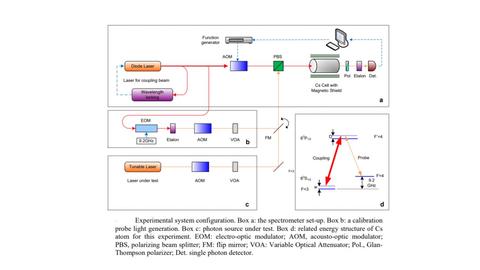Problem
Patent Description
In future quantum communication systems, single photons, as the information carriers, are required to possess very narrow linewidths and accurate wavelengths for an efficient interaction with quantum memories. Spectral characterization of such single photon sources is necessary and must be performed with very high spectral resolution, wavelength accuracy and detection sensitivity. NIST has created a method to precisely characterize spectral properties of narrow-linewidth single-photon sources using an atomic vapor cell based on electromagnetically-induced transparency (EIT). By using an atomic cesium vapor cell, NIST has experimentally demonstrated a spectral resolution of better than 150 kHz, an absolute wavelength accuracy of within 50 kHz and an exceptional detection sensitivity suitable for optical signals as weak as −117 dBm.

Invention
A direct absolute spectrometer includes: a first light source; a second light source; an optical combiner that produces dual light; an optical cell that receives the dual light; an electromagnetically induced transparent medium that is optically transparent to single photon light in a presence of pump light, such that output light is produced; and a filter that filters output light and provides EIT light free from, wherein electromagnetically induced transparent EIT light is a direct and absolute metric of a linewidth and a wavelength of single photon light such that the direct absolute spectrometer provides direct and absolute determination of the linewidth of the single photon light and direct and absolute determination of wavelength at a maximum of intensity of the single photon light.
Features
Current main spectrometers are based on dispersive optical elements, which limits its resolution to GHz. In addition, it needs to be calibrated by atomic cells to provide absolute wavelength reading. This invention directly uses an atomic optical phenomenon, that provides sum-MHz resolution and absolute wavelength reading.

